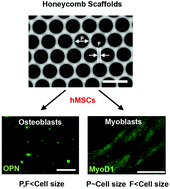Honeycomb-shaped surface topography induces differentiation of human mesenchymal stem cells (hMSCs): uniform porous polymer scaffolds prepared by the breath figure technique†‡
Abstract
Polystyrene honeycomb scaffolds with different pore sizes were successfully fabricated by casting a polymer solution under humid conditions in order to investigate the effect of porous microtopography on hMSC differentiation. We have used honeycomb scaffolds to achieve the microtopography-induced differentiation of hMSCs. Honeycomb scaffolds led hMSCs to osteospecific and myospecific differentiations depending on the size of pores. This selective differentiation suggested that surface microtopography alone may be effective for using hMSCs in regenerative medicine and tissue engineering.


 Please wait while we load your content...
Please wait while we load your content...